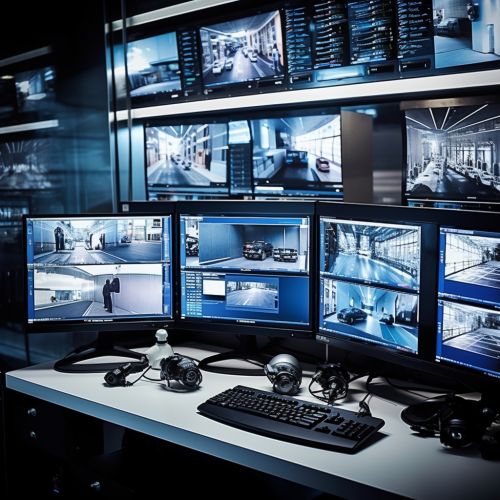Video Surveillance
Overview
Video surveillance, also known as CCTV, refers to the use of video cameras to transmit a signal to a specific place, on a limited set of monitors. It differs from broadcast television in that the signal is not openly transmitted, though it may employ point-to-point (P2P), point-to-multipoint (P2MP), or mesh wired or wireless links.


History
The history of video surveillance dates back to the mid-20th century. The first CCTV system was installed by Siemens AG at Test Stand VII in Peenemünde, Germany in 1942, for observing the launch of V-2 rockets. The system was designed for observing rocket launches from a safe distance. Over the years, video surveillance technology has evolved and improved, becoming a crucial tool in maintaining security and safety in various sectors.
Types of Video Surveillance Systems
There are several types of video surveillance systems, each with its own set of features and applications.
Analog Surveillance Systems
Analog surveillance systems are the traditional type of CCTV system. They use analog video signals that are transmitted over coaxial cable to a digital video recorder (DVR). The DVR then converts the video from an analog signal to a digital signal, allowing it to be stored on a hard drive and viewed over the internet.
IP Surveillance Systems
IP surveillance systems, also known as network video surveillance systems, capture video footage in a similar way to analog systems, but they encode the video at the camera and send it to a network video recorder (NVR) over a network cable. This allows for higher resolution video and more flexibility in terms of viewing and storing the footage.
Wireless Surveillance Systems
Wireless surveillance systems use wireless technology to transmit the video signal to the recording device. This eliminates the need for cables, making installation easier and more flexible. However, these systems can be susceptible to interference from other wireless devices.
Hybrid Surveillance Systems
Hybrid surveillance systems are a combination of analog and IP systems. They allow for the use of both analog and IP cameras, providing a flexible solution for those who want to upgrade their analog system to an IP system without replacing all of their existing cameras.
Applications of Video Surveillance
Video surveillance is used in a wide range of applications, from crime prevention to traffic monitoring.
Crime Prevention
One of the primary uses of video surveillance is for crime prevention. Surveillance cameras are often installed in public places such as shopping malls, banks, and other areas where security is a concern. The presence of cameras can deter potential criminals, while recorded footage can be used as evidence in criminal investigations.
Traffic Monitoring
Video surveillance is also used for traffic monitoring. Cameras are often installed at intersections, along highways, and in other areas where traffic flow is a concern. The footage from these cameras can be used to monitor traffic conditions, identify traffic violations, and investigate accidents.
Industrial Processes
In industrial settings, video surveillance can be used to monitor processes that are dangerous or difficult for humans to observe directly. For example, in a chemical plant, cameras might be used to monitor areas where hazardous materials are handled.
Retail
In the retail sector, video surveillance is used for loss prevention. Cameras are often installed in stores to deter shoplifting and to identify thieves.
Future of Video Surveillance
The future of video surveillance lies in the integration of artificial intelligence (AI) and machine learning technologies. These technologies can analyze video footage in real time, identifying patterns and anomalies that might indicate suspicious activity. This could greatly enhance the effectiveness of video surveillance systems, allowing for more proactive security measures.
